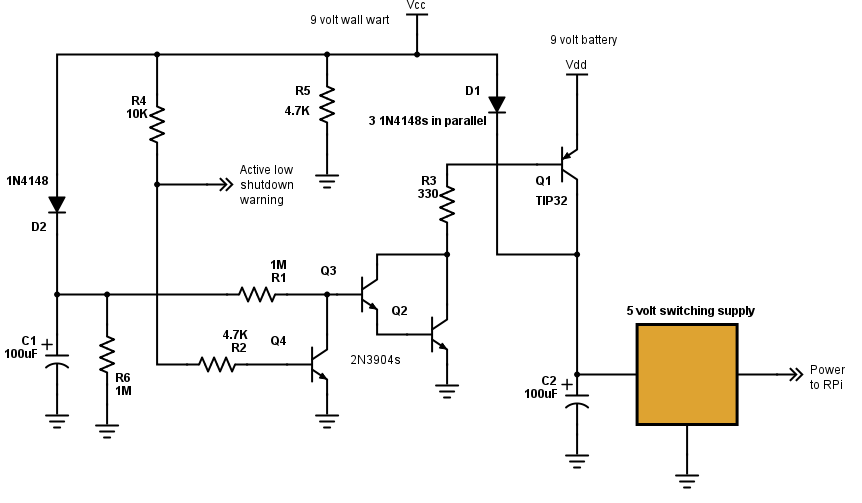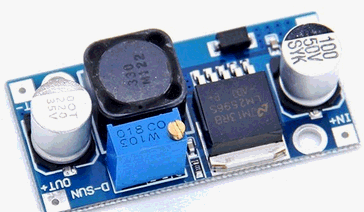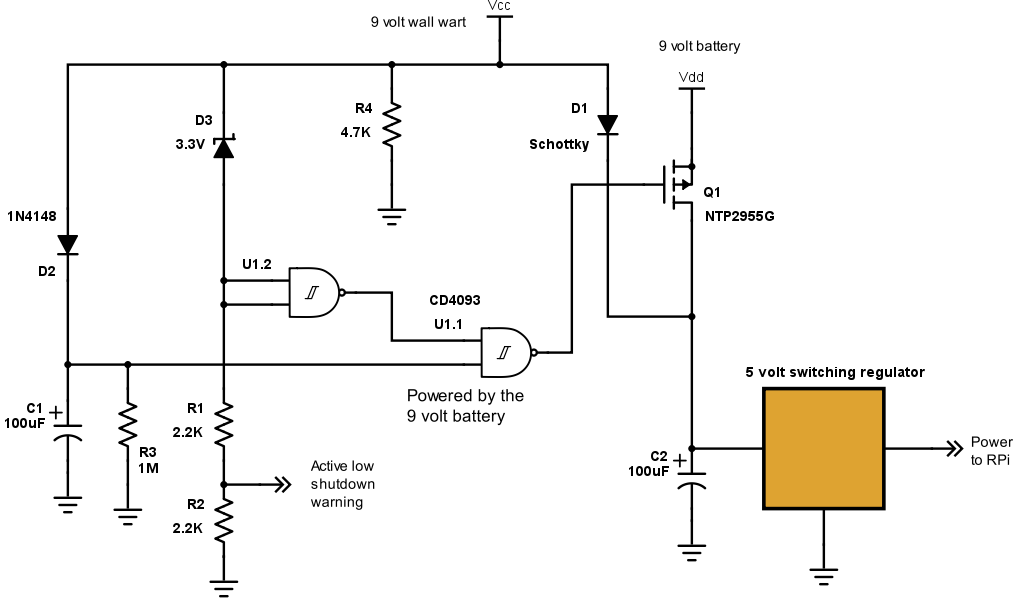The Raspberry Pi is a great little board, but because it runs Linux, you risk corrupting the file system on the SD card if you simply switch off the power. The standard advice is to type "sudo shutdown -h now" and wait until the shutdown process has finished, or has at least unmounted all the file systems, before switching off the power.
What if the RPi is part of some embedded widget with no keyboard and screen? How then to initiate a shutdown, and how to know when it's finished? It was while contemplating the creation of just such an embedded widget that I hit upon this piece of brilliance. First, build this circuit.
How does this work? When you plug in the wall wart, we don't want to draw power from the 9 volt battery yet, so we want Q1 to be off. This is accomplished by using Q4 to keep the Q2/Q3 Darlington turned off. The wall wart power flows thru the three diodes in parallel and operates the switching voltage regulator (I picked up a bunch of these from some Chinese outfit on eBay -- NOTE -- you may need to manually adjust the pot for the right voltage, as I did). Meanwhile C1 charges to around 9 volts.
What happens when you yank the wall wart? First Q4 turns off, and C1 begins to discharge thru R1 and R6, turning on the Darlington pair, which turns on Q1 so that now the switching regulator is running on battery power. The battery power remains on for some multiple of the RC time constant (100 uF * 500K = 50 secs), and you end up with about two minutes to get the Raspberry Pi to shutdown.
The active-low shutdown signal should be wired to a GPIO, which should poll it about once per second. You'll need a script on the RPi that watches this GPIO and forces a shutdown when it goes low. I've connected the shutdown warning to GPIO18.
I'm using a Raspberry Pi 2, which is much faster than the older Raspberry Pis, and reliably shuts down in only 10 or 15 seconds. So I decided to give myself the luxury of waiting 60 seconds before I commence shutdown. This means I can move the wall wart from one electrical outlet to another, and the battery power will keep the RPi alive in the meanwhile.
You'll need two scripts to make this thing work, which you'll find in this
repository. Copy shutdown.py to the /root directory. Copy shutdown.sh
to the /etc/init.d directory. While still in the /etc/init.d directory,
type update-rc.d shutdown.sh defaults, which will turn this into a service
that becomes part of your RPi's boot process. Reboot the Pi and the new service
will take effect.
One thing I had to do with the Python script was this:
apt-get install python-pip
pip install pytzI discovered a failure mode of this circuit, which is that if you slowly lower the wall wart voltage, for instance by unplugging the wall wart from the wall so that its output voltage descends slowly, you get a loss of power to the RPi because the battery power does not turn on soon enough. So you want to make sure that you are ending the wall wart power abruptly.
The fix for that is to use Schmitt triggers. It will be a while before I get a chance to prototype this circuit but here is the general idea:
The CD4093 is a CMOS Schmitt trigger quad NAND gate, powered directly by the 9v battery. All unused inputs should be tied to +9v to minimize current consumption.


